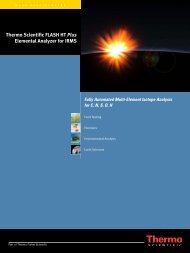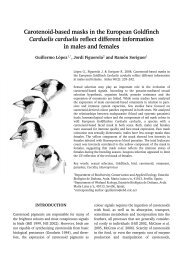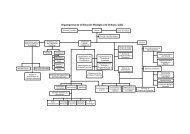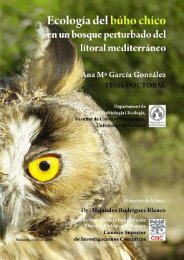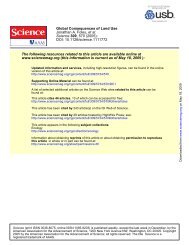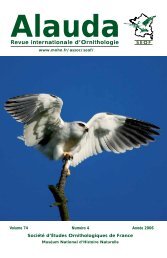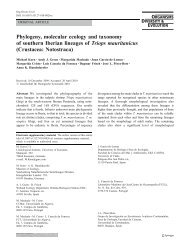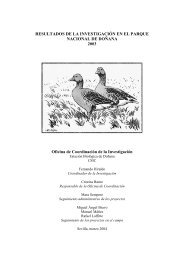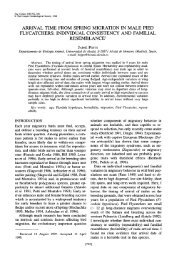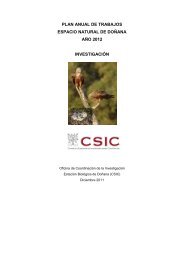Voucher Specimen Collection Preparation Identification and Storage ...
Voucher Specimen Collection Preparation Identification and Storage ...
Voucher Specimen Collection Preparation Identification and Storage ...
You also want an ePaper? Increase the reach of your titles
YUMPU automatically turns print PDFs into web optimized ePapers that Google loves.
plants or dead animals in preserving fluids... Many kinds of animals <strong>and</strong> plants that are of<br />
interest in environmental impact studies or biological surveys can only be reliably identified<br />
when they have been preserved as specimens. Without such voucher specimens it is<br />
impossible to independently verify an investigator’s claims, it is impossible to re-evaluate the<br />
species present in a sample in light of changing knowledge <strong>and</strong> taxonomic revisions, <strong>and</strong> it is<br />
impossible to reliably make historical comparisons or true ecological changes over time due<br />
to environmental effects such as pollution or climate change”.<br />
Specific voucher collections (i.e. collections of one biological group from one project) are<br />
stored as discrete units for a designated time period. This allows easy access for verification<br />
of identifications or additional taxonomic examination. After the designated time has<br />
elapsed, museum curators select appropriate specimens from the voucher collection for<br />
permanent accessioning into the main reference (research) collections. These latter<br />
collections are arranged taxonomically. Therefore, in addition to the primary reasons for<br />
making voucher collections, any government supported inventory offers the opportunity for<br />
the growth <strong>and</strong> improvement of the provincial collection.<br />
The voucher specimens, as part of the main collection, then become invaluable for other<br />
research such as studies on seasonal occurrence, distribution <strong>and</strong> biogeography, life history,<br />
<strong>and</strong> taxonomy. Biologists also have an ethical obligation to use fully any plants <strong>and</strong> animals<br />
that they collect, particularly if the species are uncommon or if they are from areas that are<br />
subsequently altered by human activity (Miller <strong>and</strong> Nagorsen 1992).<br />
Responsibilities of museums are to provide curatorial, legal <strong>and</strong> technical advice on<br />
collecting, preserving, documenting <strong>and</strong> depositing voucher specimens. Arrangements with<br />
museums for training field investigators <strong>and</strong> for accepting voucher specimens should be<br />
planned early in a project so that training needs can be met <strong>and</strong> logistical considerations can<br />
be addressed. Museums must maintain voucher specimens in good condition <strong>and</strong> make them<br />
<strong>and</strong> their data readily accessible. Field investigators <strong>and</strong> collectors are responsible for<br />
properly sampling, preserving <strong>and</strong> documenting specimens as outlined in relevant protocols<br />
<strong>and</strong> for ensuring that satisfactory samples of collections are deposited in museums after a<br />
project is completed. Investigators should cross reference voucher specimens in all reports<br />
<strong>and</strong> publications.<br />
This document should be considered a dynamic document as procedures <strong>and</strong> techniques<br />
change <strong>and</strong> improve. Note that this manual presents st<strong>and</strong>ard protocols for collecting animal<br />
vouchers only. Information on collecting <strong>and</strong> preparing plant <strong>and</strong> fungi vouchers is covered<br />
in manual No. 4b.<br />
1.1 Ethical Considerations<br />
The inventory <strong>and</strong>/or management of free-living wild mammals, birds, reptiles <strong>and</strong><br />
amphibians may require their capture <strong>and</strong> h<strong>and</strong>ling <strong>and</strong>/or collection for the identification of<br />
specific characteristics as well as for other purposes. Guidelines in the Live Animal Capture<br />
<strong>and</strong> H<strong>and</strong>ling Guidelines, manual no. 3, present a st<strong>and</strong>ardized approach to the justification<br />
<strong>and</strong> ethical considerations research <strong>and</strong> operational wildlife workers should consider when<br />
planning <strong>and</strong> performing the capture <strong>and</strong> h<strong>and</strong>ling of any wild animal. It is expected that<br />
protocols in the above mentioned manual will be followed, as this information will not be<br />
2 June 9, 1999



